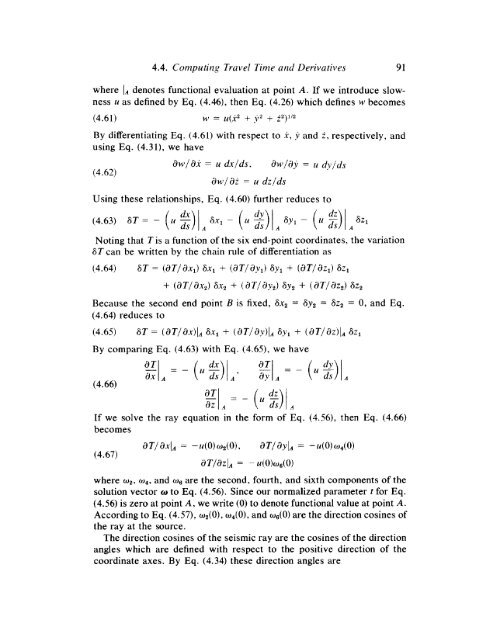principles and applications of microearthquake networks
principles and applications of microearthquake networks
principles and applications of microearthquake networks
Create successful ePaper yourself
Turn your PDF publications into a flip-book with our unique Google optimized e-Paper software.
4.4. Computing Travel Time <strong>and</strong> Derivatives 91<br />
where I A denotes functional evaluation at point A. If we introduce slowness<br />
u as defined by Eq. (4.46), then Eq. (4.26) which defines w becomes<br />
(4.61) N' = u(X2 + ?',2 + Z2)112<br />
By differentiating Eq. (4.61) with respect to X, y <strong>and</strong> z, respectively, <strong>and</strong><br />
using Eq. (4.31), we have<br />
(4.62)<br />
dw/dx = u d.r/ds. a~/aj = IA &/ds<br />
awqai = u dz/ds<br />
Using these relationships, Eq. (4.60) further reduces to<br />
Noting that T is a function <strong>of</strong> the six end-point coordinates, the variation<br />
6T can be written by the chain rule <strong>of</strong> differentiation as<br />
(4.64) 6T = (dT/dxl) 6x, + (dT/ay,) 6y1 + (dT/dzl) 6z,<br />
+ (dT/dx,) 6xz + (dT/ dy2) 6y2 + (aT/dz,) 6z2<br />
Because the second end point B is fixed, 6x2 = 6y, = 8z2 = 0, <strong>and</strong> Eq.<br />
(4.64) reduces to<br />
(4.65) 6T = (dT/dx)I, 6x, + (aT/dy)lA 6y, + (dT/dz)l, 6z,<br />
By comparing Eq. (4.63) with Eq. (4.65), we have<br />
(4.66)<br />
If we solve the ray equation in the form <strong>of</strong> Eq. (4.56), then Eq. (4.66)<br />
becomes<br />
(4.67)<br />
aT/axl, = -u(o)w~(o),<br />
aT/azl, = - u(O)o,(O)<br />
dT/dyl, = -u(O)w,(O)<br />
where w2, w4, <strong>and</strong> 06 are the second, fourth, <strong>and</strong> sixth components <strong>of</strong> the<br />
solution vector o to Eq. (4.56). Since our normalized parameter t for Eq.<br />
(4.56) is zero at point A, we write (0) to denote functional value at point A.<br />
According to Eq. (4.57), wz(0), w4(0), <strong>and</strong> ~ ~(0) are the direction cosines <strong>of</strong><br />
the ray at the source.<br />
The direction cosines <strong>of</strong> the seismic ray are the cosines <strong>of</strong> the direction<br />
angles which are defined with respect to the positive direction <strong>of</strong> the<br />
coordinate axes. By Eq. (4.34) these direction angles are






